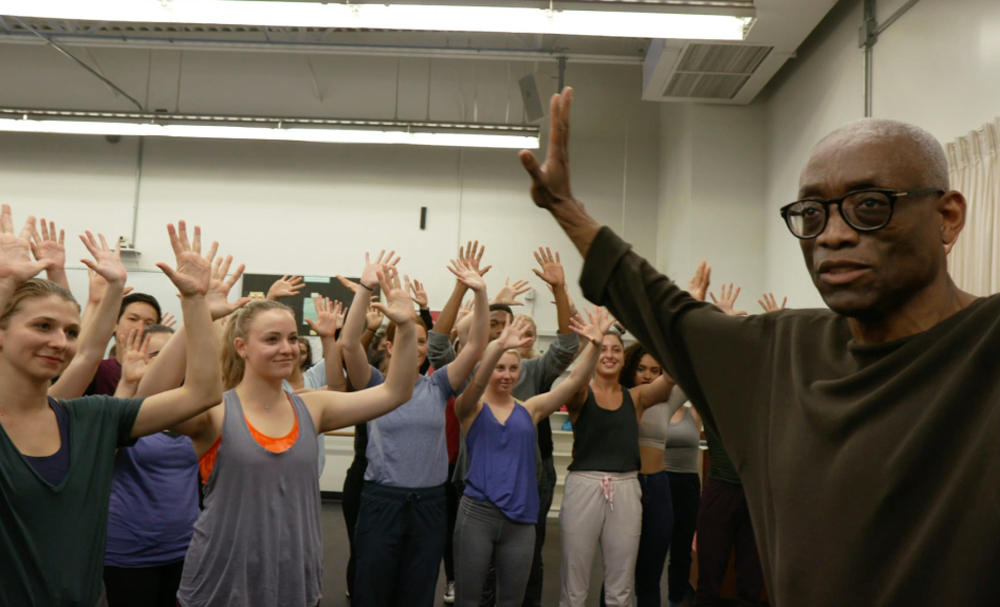“It’s amazing how much I don’t remember,” Bill T. Jones says at one point in “Can You Bring It: Bill T. Jones and D-Man in the Waters,” recounting the 1989 production of a show that he was understandably unconscious for much of its creation, having recently lost Arnie Zane, his partner in both his company and life, and wanting to honor Demian Acquavella, a dancer in their troupe who passed away at just 32, after both battled AIDS. As the legendary choreographer and dancer wondered whether the groundbreaking company he created with Zane would continue or even could it, the question of where to begin was clearly best answered by others in the company, with Jones simply turning on some Felix Mendelssohn and asking those around him to simply move to the music.
“Be careful of what you do in rehearsal because you may be doing it for a long time,” laughs Gregg Hubbard, one of those who took Jones’ lone instruction of imagining how they would wade into a body off water and dove in deeply, in “Can You Bring It,” an extraordinary collaboration between one of his fellow dancers Rosalynde Le Blanc and Tom Hurwitz, a renowned cinematographer behind such docs as “The Queen of Versailles” and “Our Brand is Crisis.” With only hazy VHS tapes left as documentation of the original staging of “D-Man in the Waters,” the film brings its legacy into sharp relief with an oral history that somehow articulates a show that’s always defied description, rooted in the deep pain of a community that had been rocked by a pandemic and had few outlets where they could express themselves and be heard besides their art.
However, LeBlanc, now part of the faculty at Loyola Marymount University, takes things one step further in reviving “D-Man” for a class production in which students who may only have a passing familiarity with the AIDS crisis during the early 1980s find their own meaning in the dance. Cross-cutting between recollections from the original company and rehearsals for “D-Man” in the present day, the film not only shows the profound effect it has on anyone that performs the dance, but as bodies contort in extraordinary ways, there is a fascinating push-and-pull revealed between honoring the original intentions of the piece and letting it take on a life of its own as it moves further away from the time it was created in, making clear that the tension is what defines a truly great work of art and keeps it alive and open to reinterpretation and reconsideration over the years.
Out of one towering achievement grows another with “Can You Bring It” and with the film arriving in theaters and virtual cinemas this week, LeBlanc and Hurwitz spoke about how meeting during the creation of “Still/Here,” Jones’ 1995 show about grappling with chronic illness that he wisely did document for posterity, led to reuniting to tell the story of this landmark production, blending their skills as a dancer and cinematographer, respectively, into capturing what a dynamic experience the show is and how it continues to inspire until this day.
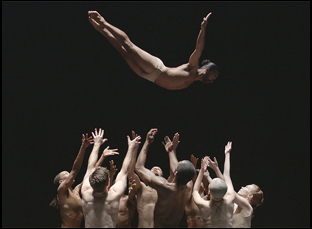
Rosalynde LeBlanc: In 2012, I was interested in the treasure chest that a dance can become, especially one that was made at such a charged historical time as this one [“D-Man in the Waters”], the height of the AIDS crisis and what all that embodied knowledge that the dance carries and how that move forwards as the dance is restaged. I had restaged the piece a couple times in a couple different colleges and consistently ran up against a generation gap where the students who were learning it didn’t quite understand fully the kind of dynamism and tragedy with a political mobility that was happening at the same time as the AIDS crisis. That was what spurred the idea and [because] Tom and I worked together on “Still/ Here,” I reached out to him, just a shot in the dark to see if he would beAY willing and able to come onboard. He is a big-time cinematographer, so I really didn’t know if he would, but he did and our collaboration started around 2013.
Tom Hurwitz: I remembered Ros very clearly from “Still/Here” and followed her career as the years went on, but we hadn’t really talked after that, so when she called and said, “You want to do this?” I was eager to because she was clearly a great artist. Then we started shooting the interviews as part of what we thought of as a relatively small project to have that enable the transfer of the dance — the putting of the dance on a company that hadn’t experienced what was at stake in the original dance — in the original ballet. But as we saw the interviews develop, it became clear this story was much richer and had so much more potential than just that idea, so when we were done, Ros and I had a meeting and I just said, “This is a feature. We can really make a documentary out of that.” Little did I know that eight years later, we’d be opening the film. [laughs]
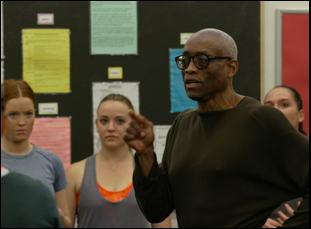
Rosalynde LeBlanc: Yeah, we had already been filming at that point for three years and carving/crafting/working on narrative and figuring out what this film was going to be and the choice to film at Loyola Marymount and have me restage the dance there did not become a possibility until late 2015/early 2016. It was a big, pivotal moment because of course that put me in the film and that was something that Tom and I had to talk about a lot in terms of how that forms the narrative, how that affects my role as producer/director and ultimately a type of honesty and disclosure. My history with “D-Man in the Waters” and with Bill T. Jones was my story as well, so it allowed that aspect of it to be transparent and not just behind the scenes but actually playing out on the screen.
Tom Hurwitz: And though I had sympathy for Ros’ feeling of exposure, I knew that it would raise the stakes overall on the film and we both really felt it would provide an element of immediacy, although it would structurally be a terrific challenge to center a film in two time [periods] at once. At the same time, it really provided a closeness that we wouldn’t have been able to get any other way, so it allows people to identify with those young dancers, so we had a sense that this was going to happen. Of course, these were Southern California women and men and they’ve lived very different lives than the lives of the original company, so one never knows what’s going to happen, but they were wonderful and they brought it and we had a film.
It seems like you’re grappling with this same question of how much do you tell a history in this film versus capturing what’s in the moment and letting it take on a life of its own. Was it difficult to figure out?
Tom Hurwitz: That’s something that takes place in the cutting room because all of that balancing and structuring the material that we had, so it’s hard to think of that as it’s happening. You have to trust that your instincts are right. In a documentary, there are certain things you feel and certain things you know and as you’re shooting, a certain percentage is feeling, “I know this is going to work,” but how it’s going to work and where it sits, all of that happens in the editing.
Rosalynde LeBlanc: I discovered a wonderful kind of commonality between dance and documentary filmmaking because in the process of restaging a dance, especially a historical one, the biggest task is to put that dance back in relationship to the contemporary world and to the dancers of that moment and to build the relationship to your contemporary audience, so that idea is very active in the studio of how do we give this relevance today, even though it’s a historical work.
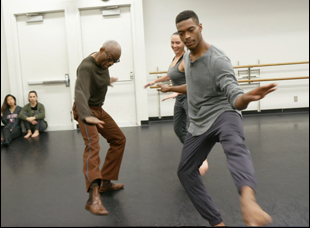
Rosalynde LeBlanc: I think that was one of our most successful moments of collaboration, and sometimes I wished that somebody could’ve been documenting our collaboration in that way because really what I could tell Tom was, “This is how this feels onstage. This is what it’s like when the lights are on you and this sweaty person comes over and when you’re backstage and you’re running this way and you have to get on it.” tHe took that information and he said, “Okay, we need this camera placement here and we need this type of camera, and this many cameras,” so that was a wonderful translation that he and I developed.
Tom Hurwitz: And because this film was about the relation of the dancers to the work and what it did to them, the performing of the work as much as the creation of the work, so I knew we had to shoot it in a very special way so the camera itself had to feel like a dancer. That was very tricky and I don’t think it’s ever been done very successfully until now. It involved changing the lighting of the piece.
That’s one of the things that one doesn’t think about, but a reason why dance isn’t shot on stage very much is because dance is always lit from the side, so every time the camera looks into the wings, the camera lens gets blown out by the intensity of the side light. We had to be able to edit the shots that we shoot onstage with the shots that were shot from the audience point of view, which we call proscenium, so it had to all match. We had a wonderful gaffer that we worked with who also did stage lighting so he could put our ideas into practice and Ros was very clear about which elements of the dance needed to be isolated and shot on stage, so we talked about how we’d do it and which ones we’d do and then we went ahead and did it. It took one day to shoot from the audience point of view and three days to shoot onstage. The dancers were were just wonderful to work with and it was a very rich process.
Was there any moment in this in the process of making this that changes your ideas of what this could be?
Tom Hurwitz: For me, there were several. When we finished the interviews, I knew this was a vastly bigger film than we started out to make. When Ros had the effect that she had on the dancers in the final rehearsal and they began to open up and feel it and were able to really do the ballet on stage better than they’d ever done it before with real feeling and connection because of what she brought out of them, I really knew that we had a film.
Rosalynde LeBlanc: For me, those moments were when I had my producer hat on a little more because when I’d communicate with Demian Acquavella’s family, for one, and the original dancers, I was feeling the overwhelming emotion from both of those groups about stories that just had not yet been told and that they had been carrying around in their memories and their bodies. Now someone was asking them what it was like and even phone conversations to plan the interviews, the amount of emotions [that were there were] moments for me that I really felt like this is bigger than me. There were both moments of joy and fear for me in those moments because I realized how much larger it was than me.
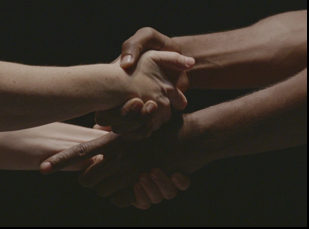
Rosalynde LeBlanc: It feels wonderful to have the dance preserved and more so just to have, for lack of a better word, the hugeness of this dance indicated to the world. There still are secrets in this dance. We shot it all, but we didn’t necessarily put it all in the film and I think that’s right because there is a certain amount of sanctity of the inner workings of the dance that only Bill T. Jones and those that have a chance to perform it know. That feels only right.
Tom Hurwitz: I haven’t said this before, but Ros leads me to it, [which] is something that I’d been wanting to say about the act of creativity. It has to do with Bill and his prophetic voice. This dance is about grace. It’s about the action of something bigger than all the people involved in it and connected to a moment in history and something that’s universal, that doesn’t go away and doesn’t get stuck in a period of time. It has to do with the work of the human spirit and I’m really excited to have a film that says this out there.
“Can You Bring It: Bill T. Jones and D-Man in the Waters” opens on July 16th at Film Forum in New York and will be available in virtual cinemas.




